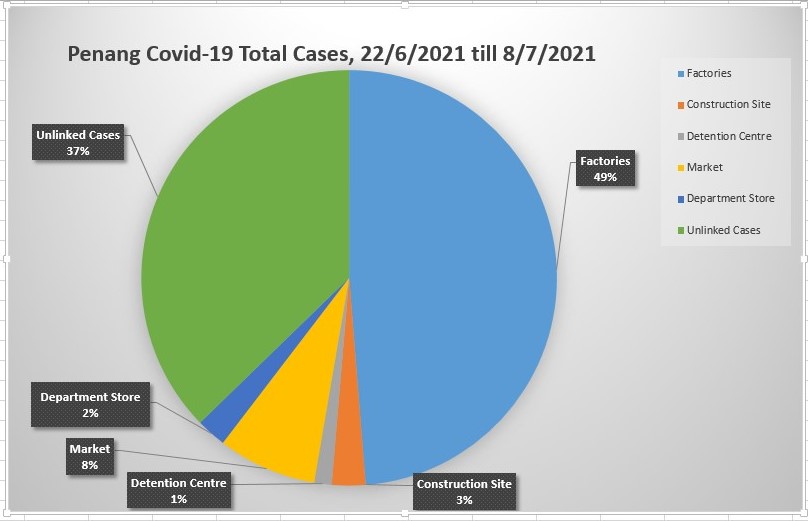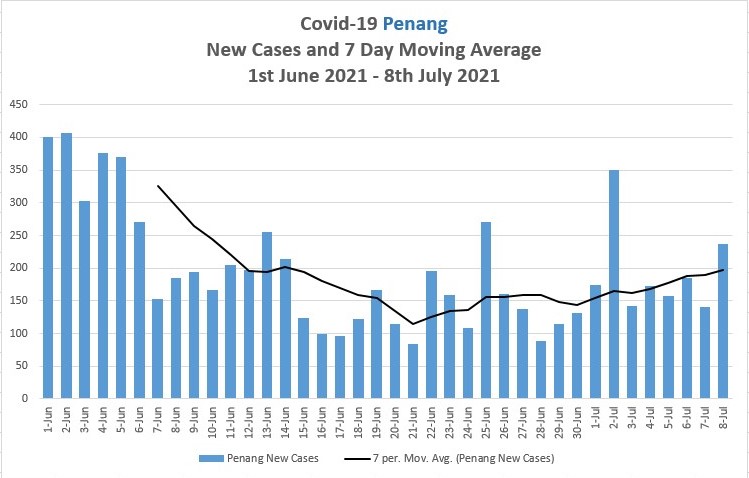GEORGE TOWN, July 9 – Much has changed during the past 17 days. We now have a deputy prime minister, as well as a new senior minister, and a reshuffling of ministerial portfolios is anticipated. Yet one thing is constant, and that is Covid-19.
My last look at the data for Penang cases showed a downward trend for the period between June 4 and June 21. In fact, an overall look at the period from June 1 and July 8 reveals a seven-day moving average that might translate into a downward trend.
What caused a bump in the numbers was a sudden spike of 351 cases on July 2 (with half coming from a single cluster) which would have upped the moving average into July.
We have always been worried about sporadic or unlinked cases, and rightly so when the health director-general declared that we had over 80 per cent of such cases in Malaysia back on May 11.
Even in Penang, the percentage of sporadic cases rose from 55.4 per cent (March 19 to May 9) to 68.5 per cent (May 10 to June 3), although there was a drop to 53.4 per cent during June 4 and June 21).
Based o this premise, let us now examine the data for June 22 to July 8, which yields a total of 2,923 cases for that 17-day period, out of which 1,070 are unlinked, while 1,853 are from clusters.

In fact, we saw a significant drop in unlinked or sporadic cases in Penang, which are now at just 36.6 per cent. Reversely, that means the cluster cases make up 63.4 per cent (up from 46.6 per cent for June 4 to June 21).
Yet, this does not necessarily translates into a deterioration of the situation. In fact, it reflects a pattern of more effective contact tracing done by staff from the state health department.
So for the 1,853 cluster cases, 1,399 are from factories (75.5 per cent), 211 from normal or wholesale markets (11.9 per cent), 67 from department stores (3.6 per cent), 39 from detention centres (2.1 per cent), 75 from construction sites (4.0 per cent) and 52 from medical facilities (2.8 per cent).
There was never a doubt that factories make up the majority of the cluster cases, yet in terms of percentage of the cluster cases, it is fairly constant at the current 75.5 per cent, compared to 74.8 per cent (June 4 to June 21) or 76.2 per cent (May 10 to June 3) or even 75.2 per cent (March 19 to May 9).
Hence, factory cases will always be there. We had faced a sustained outbreak on the island late last year with many clusters. This time, we are seeing sustained cases from ever increasing factory clusters on the mainland. In fact, these clusters overlap with cases from Perak and Kedah.

This is a persistent problem in a particular area of Penang, hence a field hospital was set up at Kepala Batas on May 25 to alleviate the situation.
We are, as they say, still in the midst of a war. Worse still is that the lockdown since June 1 coupled with Full Movement Control Order (FMCO) restrictions have led to more hardship for more people, leading to more despair.
Therefore, it is good to see that the #BenderaPutih or #WhiteFlag initiative has started to help those in need. Yet, we still need a concerted effort by all Malaysians, to do our part to combat this menace by observing SOPs.
Vaccination is moving, albeit at a gradual pace in Penang (hoping to pick up soon). ICUs and hospital beds with health care workers are stretched to their limits, both physically and mentally.
We sincerely hope for things to get better. Let us see this change start from the top, the sooner, the better.








